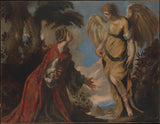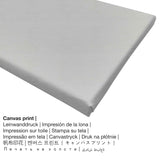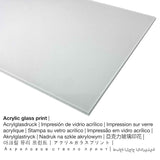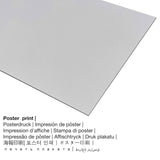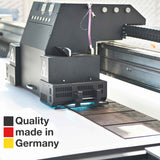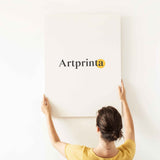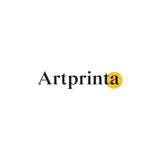Francesco Maffei, 1657 - Hagar na mmụọ ozi - mbipụta nka mara mma
Ụtụ gụnyere. Mbupu gbakọrọ na ndenye ọpụpụ.
Data data
Ihe osise aha ya Hagar and the Angel e kere ya Francesco Maffei na 1657. The 360 year old version of the masterpiece had the following size of 41 3/4 x 54 in (106 x 137,2 cm) and was crafted with the Usoro of mmanụ na kwaaji. N'oge a, a na-etinye mpempe nka na mkpokọta nka dijitalụ nke Museumlọ ihe ngosi nka nke Obodo in New York City, New York, Njikota Obodo Amerika. Site n'ikike nke - Ụlọ ihe ngosi nka nke Metropolitan, New York, Arịrịọ nke Anna Mont, na ebe nchekwa nke Frederick Mont, 2010 (ọha na eze). Furthermore, the artpiece has the creditline: Bequest of Anna Mont, in memory of Frederick Mont, 2010. In addition to this, the alignment is odida obodo ya na oke nke 4: 3, meaning that the length is 33% longer than the width. The painter Francesco Maffei was a European artist, whose art style can primarily be attributed to Baroque. The European painter was born in 1605 in Venice, Venezia province, Veneto, Italy and passed away at the age of 55 na 1660.
Ozi mgbakwunye sitere na The Metropolitan Museum of Art (© - nke Ụlọ ihe ngosi nka nke Obodo ukwu - www.metmuseum.org)
Maffei, who lived and worked in the cities of Vicenza and Padua, was profoundly influenced by the art of Bassano, Tintoretto, and Veronese, his Venetian predecessors. His style is characteristic for its elegance, far removed from realism. This scene from the Biblical book of Genesis shows the angel appearing to Hagar. Having been banished by Abraham to the desert with her infant Ishmael, she is saved by a heavenly creature who directs her to a spring of water.
Ozi ndabere nka
| Iberibe aha nka: | "Hagar and the Angel" |
| Nhazi nka: | sere |
| Nhazi nka: | nka ochie |
| Nhazi oge: | 17th narị afọ |
| Afọ nka: | 1657 |
| Afọ nka: | ihe karịrị afọ 360 |
| Usoro izizi: | mmanụ na kwaaji |
| Nha ihe osise izizi: | 41 3/4 x 54 inch (106 x 137,2 cm) |
| Ụlọ ihe ngosi nka: | Museumlọ ihe ngosi nka nke Obodo |
| Ebe ngosi nka: | New York City, New York, Njikota Obodo Amerika |
| Ebe nrụọrụ weebụ ihe ngosi nka: | Museumlọ ihe ngosi nka nke Obodo |
| Ikikere nke ihe osise: | ngalaba ọha |
| Site n'aka: | Ụlọ ihe ngosi nka nke Metropolitan, New York, Arịrịọ nke Anna Mont, na ebe nchekwa nke Frederick Mont, 2010 |
| Ebe E Si Nweta: | Arịrịọ nke Anna Mont, na ebe nchekwa nke Frederick Mont, 2010 |
Nchịkọta nkenke nke onye na-ese ihe
| Aha onye nka: | Francesco Maffei |
| Aha ndi ozo: | Maffei, Maffei di Vicenza, Francesco Maffei di Vicenza, Maffei vicentino, Francesco Maffei, Mafei, Maffei Francesco, Francesco Mafei da Vicenza |
| okike onye nka: | nwoke |
| Obodo onye nka: | Italian |
| Ọrụ: | onye na-ese ihe |
| Country: | Italy |
| Nkewa onye nka: | nna ukwu ochie |
| Ụdị nka: | Baroque |
| Oge ndu: | 55 afọ |
| Afọ ọmụmụ: | 1605 |
| Obodo: | Venice, mpaghara Venezia, Veneto, Italy |
| Afọ ọnwụ: | 1660 |
| Nwụrụ na (ebe): | Padua, Padova province, Veneto, Italy |
Ngwa ngwaahịa ị nwere ike ịhọrọ
Anyị na-enye ihe dị iche iche dị iche iche na nha maka ngwaahịa ọ bụla. Anyị na-ahapụ gị ka ịhọrọ n'ime ụdị ndị a:
- Kwaaji: The printed canvas, not to be confused with an artwork painted on a canvas, is an image printed from a UV direct printer. It makes a plastic look of three-dimensionality. The great advantage of canvas prints is that they are relatively low in weight, meaning that it is easy to hang up the Canvas print without any wall-mounts. Canvas prints are suitable for all kinds of walls.
- Mpempe akwụkwọ mmado ebipụtara na akwa akwa: A poster print is a printed canvas paper with a slightly rough texture on the surface. It is suited for framing your art print with the help of a custom frame. Please note, that depending on the size of the poster print we add a white margin between 2-6cm around the painting in order to facilitate the framing with your custom frame.
- Aluminom dibond (ọkpụkpụ ọla): These are metal prints on aluminium dibond material with an outstanding depth effect. A direct Aluminium Dibond Print is the excellent start to art reproductions on aluminum. This UV print on aluminium is one of the most demanded entry-level products and is a truly sophisticated way to showcase art reproductions, because it draws attention on the replica of the artwork.
- Mbipụta iko acrylic (nke nwere ezigbo mkpuchi iko): The acrylic glass print, often referred to as a an art print on plexiglass, transforms the original work of art into beautiful décor. Your favorite artwork is printed with the help of modern UV printing machines. It makes rich and impressive color shades. With an acrylic glass fine art print sharp contrasts as well as minor color details become more recognizeable thanks to the subtle gradation of the print. The plexiglass with real glass coating protects your chosen art replica against light and heat for many years to come.
Nkọwa ngwaahịa
| Nkewa bipụta: | ọrụ mgbidi |
| Mmeputakwa: | mmeputakwa n'ụdị dijitalụ |
| Usoro nhazi: | mbipụta dijitalụ (Mbipụta UV ozugbo) |
| Mmalite ngwaahịa: | Germany |
| Ụdị ngwaahịa: | na mmepụta ihe |
| Ngwaahịa were: | nchịkọta nka (mmeputakwa), ihe ndozi mgbidi |
| Ndepụta: | usoro odida obodo |
| Oke akụkụ: | ( Ogologo: obosara) 4: 3 |
| Ihe: | ogologo bụ 33% ogologo karịa obosara |
| Ụdị dị iche iche dị: | Mbipụta kwaaji, mbipụta enyo acrylic (nwere ezigbo mkpuchi iko), mbipụta ọla (aluminium dibond), mbipụta akwụkwọ mmado (akwụkwọ kwaaji) |
| Canvas dị n'elu ihe nrịbama (mbipụta kanvas) nha dị iche iche: | 40x30cm - 16x12", 80x60cm - 31x24", 120x90cm - 47x35", 160x120cm - 63x47" |
| Mpempe iko acrylic (nwere ezigbo mkpuchi iko) nha dị iche iche: | 40x30cm - 16x12", 80x60cm - 31x24", 120x90cm - 47x35", 160x120cm - 63x47" |
| Nhọrọ nha nke akwụkwọ mmado (akwụkwọ kwaaji): | 40x30cm - 16x12", 80x60cm - 31x24", 120x90cm - 47x35" |
| Nha aluminom dibond (ihe aluminom) nha: | 40x30cm - 16x12", 80x60cm - 31x24", 120x90cm - 47x35" |
| ụba: | biko buru n'uche na mmeputakwa a enweghi etiti |
Ederede iwu dị mkpa: We try whatever we can to depict our products in as much detail as possible and to display them visually in our shop. Please bear in mind that the tone of the printed materials and the printing might diverge to a certain extent from the presentation on the device's monitor. Depending on the screen settings and the nature of the surface, colors can unfortunately not be printed as exactly as the digital version. Given that all the fine art prints are processed and printed manually, there might as well be slight discrepancies in the motif's exact position and the size.
© Nwebiisinka - ikike ọgụgụ isi nke, Artprinta.com (Artprinta)

